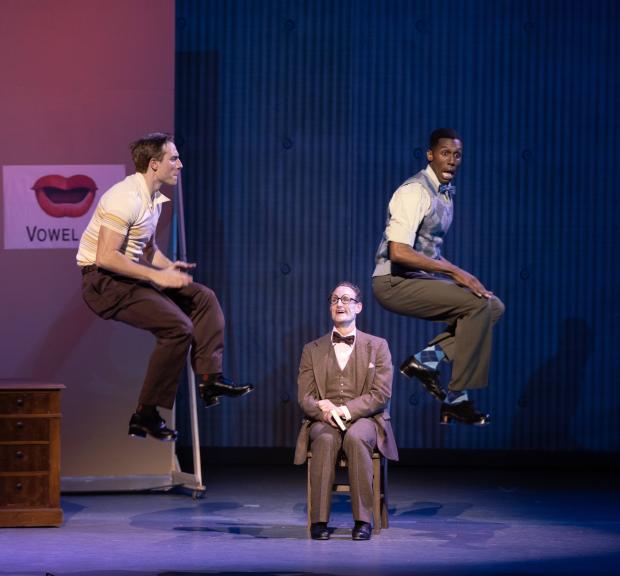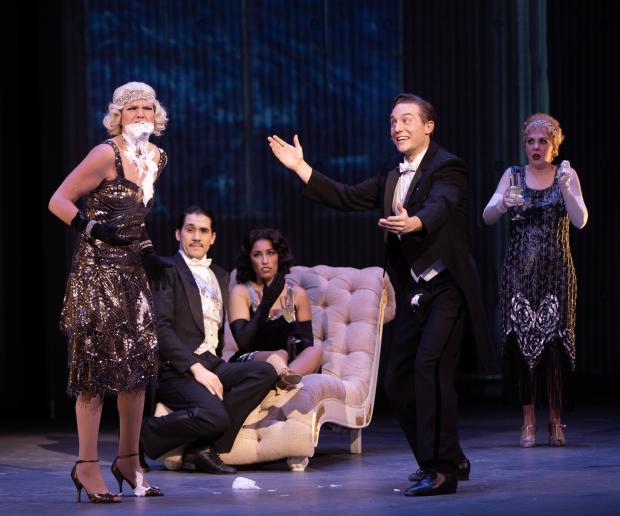Advertisement
Premiering as it did hard on the heels of the annual TCM Classic Film Festival, the must-see musical Singin’ in the Rain live onstage now at the La Mirada Theatre for the Performing Arts is like a delicious dessert conjured up by a three-Michelin star chef following an exquisite five course meal. This theatrical production is adapted by Betty Comden and Adolph Green from the book of their 1952 screen masterpiece starring Gene Kelly, Debbie Reynolds and Donald O’Connor, also with music by Nacio Herb Brown and lyrics by Arthur Freed (the theatre iteration opened in the 1980s on West End and Broadway stages).
As a film historian who has authored/co-authored four movie history books I had expected to enjoy Rain, which takes place in Hollywood as the motion picture industry transitions from the silent cinema to talkies. Having attended about 12 plays at the playhouse, I’d observed that La Mirada’s bill of fare generally consists of crowd pleasing musicals intended to entertain and sell tickets to a middlebrow audience. But I underestimated the 1,250-seat venue, which actually won three of the 29th LA Stage Alliance Ovation Awards at the annual ceremony last January, and had scored the most prestigious Ovation, for Best Season, in 2013.
I not only thoroughly enjoyed this almost two hour, 40 minute two-acter, but fell in love with this entrancing, enchanting live stage version of a classic movie. We live in dark days that can get downright depressing, and during periods like ours theatre can serve several functions, such as plumbing the depths of the human condition and exploring society’s ills. But works such as Rain take another tack, illumining the innate goodness of people and instilling a sense of sheer exuberance in joie de vivre: The act - and art - of the joy of living.
Rain’s dancing (Spencer Liff is credited as director/choreographer, with musical direction by Keith Harrison, while the film’s co-directors Stanley Donen and Kelly share an Original Movie Choreography credit), songs played by a 16 piece live orchestra conducted by Harrison, acting, dialogue, performances, are all stellar. With the exception of the superb title number, most of the show’s sets by John Iacovelli are pretty humdrum, enlivened by David Murakami’s projections. (BTW, there are clever projections of silent screen stars when the curtain lifts duirng a Grauman’s Chinese Theatre motion picture premiere - however while 21st century auds may recognize the “Little Tramp”, Charlie Chaplin, how many will be familiar with Theda Bara, “the Vamp”? The projection designer might want to include some labels so ticket buyers know who they are looking at.)
Michael Starr (last seen on La Mirada’s boards in its previous musical, 1776) stars as Don Lockwood (the silent cinema swashbuckler Gene Kelly played in the movie rendition), paired onscreen opposite the egomaniacal Lina Lamont (Sara King, who has appeared on the Great White Way and in TV programs such as Mr. Robot), a celebrity who has read - and believed - too much of the tabloid press about her, including Don and Lina’s supposed offscreen romance.
Some welcome nontraditional casting completes Rain’s key quartet. NYU drama grad Kimberly Immanuel co-stars as Kathy Selden (Debbie Reynolds’ part), the erstwhile stage actor whose criticism of Don’s “dumb show” technique (or lack of) strikes a chord with the onscreen daredevil of derring-do, who is no Method actor. Brandon Burks portrays Don’s longtime friend, the song-and-dance-man Cosmo Brown, depicted by Donald O’Connor in the original. According to her website, Immanuel has been cast in Pacific Overtures and Miss Saigon, and she appears to be of Asian or part-Asian ancestry - quite a contract to Reynolds’ blonde, “all-American girl” character. Burks, unlike O’Connor, is an African American, and it’s great that 67 years after the movie premiered, the talent pool has been opened up for considerations beyond ethnicity in parts that are not race-specific per se, and the deciding factor in determining who gets cast is talent (not nationality), which both Immanuel and Burks clearly have in abundance. Using this method to cast performers is not only fairer to the artists, but to audiences, as well, who get to see and enjoy the best man (and woman!) for the role.
The ensemble also includes a number of hoofers, too many to be identified individually. But they are typified by Clarice Ordaz, who was one of the traffic dancers in the fantastic opening of La La Land (which bears some thematic and musical similarity to Rain). Early in Act I the diaphanous Clarice appears clad in a black flowing skirt in a lovely dance interlude, and this sensuous beauty graces the stage throughout much of the show. In addition to being part of the ensemble, the dazzling Ordaz serves as the production’s dance captain and assistant choreographer.
As Rain grapples with the technically challenging switchover from silent cinema to synchronized sound, innovations such as dubbing are stumbled upon. The musical’s denouement could be called “dub and dubber” and this play is, BTW, as funny as (and wittier than) that 1994 comedy Dumb and Dumber starring Jim Carrey. Another technical innovation Cosmo introduces is a “flash forward,” which enables the company to add a huge, modern day dance number to the latest Lockwood-Lamont extravaganza, a period piece initially titled The Dueling Cavalier. However, desperate to produce a hit like the Warner Bros.’ 1927 talkie The Jazz Singer, the so-called Monumental Pictures’ studio has revamped the silent film, transforming it into a musical now called The Dancing Cavalier. This despite the exasperation of director Roscoe Dexter (jovial Jamie Torcellini), who objects on the grounds that, like, you know, Cavalier is set during the French Revolution - when there was no tap dancing.
Nevertheless, Act II includes an extended “Broadway Melody” number
that seems to be a sort of homage to Gene Kelly’s hoofing. During this sequence Breanne Wilson steals the show as the sexy Cyd Charisse-like dancer. For some, this excursion into Kelly choreo may be over the top and conflict with the tight storytelling of the rest of Rain, while others may revel in this tribute to Gene’s thrilling, fancy footwork.
The musical includes beloved songs such as “Make ‘Em Laugh”, “You Are My Lucky Star” and of course the title number, which is expertly, masterfully, sensationally depicted onstage in a very exciting extravaganza full of special effects, along with Starr’s super duper dancing and music. However, it is the hit that precedes Singin’ in the Rain which is my personal favorite, “Good Morning”, which that titanic trio of Starr, Immanuel and Burks bring alive onstage with great panache, even using the couch as a great prop, as Debbie and company did onscreen. (I once heard Reynolds claim at a TCM Fest that, rather remarkably, before shooting Rain she’d never professionally danced before!)
And as Rain was performed on Passover, it even boasts the perfect song for that Jewish holiday: “Moses Supposes”! (The hearty post-show reception even provided a seder feast!)
In the second act King shines as the villainess you love to hate in her dressing room song which could be called “Lamont’s Lament”, but is actually titled “What’s Wrong With Me” (lyrics by Edward Heyman). Full of narcissism, self-pity, egoism and megalomania, the number could have been warbled by that other bleached blonde with a brain disordered by celebrityhood, Trump. On the other hand, Lockwood and Selden, plus other characters to lesser extents, including studio mogul R.F. Simpson (Peter Van Norden, who depicted Ben Franklin in La Mirada’s recent 1776 and the 2018 Best Actor Ovation Award for appearing in Antaeus Theatre Company’s production of Harold Pinter’s The Hothouse), who try to do the right thing and act in moral ways. Given how ethically challenged much of America currently is, it’s refreshing to see people try to behave honorably.
(Appearing on CNN April 21, Trump’s attorney Giuliani was actually taken aback by being asked questions about “morality” - on EASTER SUNDAY, no less. He went on, after almost two years of investigation, to not condemn collaborating with foreign powers during electoral campaigns. These people aren’t merely immoral - which implies they have bad ethics. Rather, more properly, they are amoral, meaning that they have absolutely no ethics whatsoever, and should be overthrown ASAP.)
Attending uplifting, exuberant works that extol the human spirit helps to recharge one’s batteries after being deluged by a flood of distressing news. To be sure, Rain was by far the best production I’ve seen mounted at La Mirada. And here’s why you should strap on your best pair of dancing shoes and tap your way down to this theatrical outpost located in southeastern L.A. County:
Because you love musicals; extraordinary dancing; beautiful music; great acting; and well-told stories about movie history. But most of all, go see Rain because you love yourself and want to treat yourself, friends and loved ones to a great, special time that will simply make you feel glad to be alive, as if you are floating on air. Don’t miss what may well be the hottest ticket in Los Angeles!
FUN FACT OF THE REVIEW:
Gene Kelly was a pretty progressive guy. He eschewed Fred Astaire’s elitist top hat and tails for what Kelly biographers Cynthia and Sara Brideson, authors of He’s Got Rhythm, described as a “character” who was “proletarian”, wearing “regular Joe dancing attire.” Kelly refers to himself in their bio as the “Marlon Brando of dance” who “set a new style in dancing.” In 1947’s Living in a Big Way Kelly played “a returning veteran” who dances at a construction site for vets’ housing, including hoofing with children. The Bridesons note Kelly had a “known sympathy for unions” and the star tried mediating labor disputes.
Kelly’s 1943 World War II morale booster Thousands Cheer was written by two Communist Party members who later had their brushes with the Hollywood Blacklist - Paul Jarrico and Richard Collins, who went on to co-write the movie witch-hunters loved to hunt, 1944’s pro-Soviet Song of Russia. Kelly’s wife at the time, actress Betsy Blair, who I’d heard speak at the L.A. Times Festival of Books, was either in or close to the Communist Party during the 1940s and campaigned for Progressive Party presidential candidate Henry Wallace in 1948. Betsy likewise fell afoul of the Hollywood Blacklist.
Singin’ in the Rain is being performed 7:30 pm on Wednesdays and Thursdays; 8:00 p.m. on Fridays; 2:00 p.m. and 8:00 p.m. on Saturdays; and 2:00 p.m. on Sundays through May 12 at La Mirada Theatre for the Performing Arts, 14900 La Mirada Blvd., La Mirada, CA. For info see: www.lamiradatheatre.com or call: (562)944-9801 or (714)994-6310.
And silent screen aficionados might want to check out La Mirada’s Slapstick Sillies, a mirthful matinee featuring clips from Chaplin, Buster Keaton, Harold Lloyd, etc., comedies accompanied with live music by pianist Ben Model, 1:00 p.m., Saturday, May 18. Patricia Ward Kelly, Gene’s wife, who introduced Rain’s opening night performance, will present her one-woman show about her late husband at the La Mirada in October.
L.A.-based critic/film historian Ed Rampell co-authored “The Hawaii Movie and Television Book.” (See: https://mutualpublishing.com/product/the-hawaii-movie-and-television-book/.)



